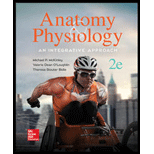
_____ 1. All of following are functions of the kidney except
- a. gluconeogenesis, the formation of glucose from non-carbohydrate sources.
- b. release of erythropoietin to control erythrocyte production.
- c. control of blood pressure through the release of renin.
- d. production of plasma proteins to control blood volume.
Introduction:
Kidney balances the water and salt concentration in the body by removal of waste products from the blood. It maintains normal blood pressure by balancing the electrolytes such as sodium and potassium. It produces red blood cells and during starvation, performs gluconeogenesis.
Answer to Problem 1DYKB
Correct answer:
Production of plasma protein to control blood volume is a function of the liver. Therefore, option d. is correct.
Explanation of Solution
Reason for the correct statement:
Option d. is given as “production of plasma proteins to control blood volume”. Protein present in blood such as albumin, fibrinogen, and globulin are produced in reticuloendothelial cells of the liver. Hence, the liver produces plasma protein which controls the blood volume.
Hence, option d. is correct.
Reasons for incorrect statements:
Option a. is given as “gluconeogenesis, the formation of glucose from non-carbohydrates source”. Gluconeogenesis occurs in the liver and kidney cortex. Hence, option a. is incorrect.
Option b. is given as “release of erythropoietin to control erythrocytes production”. Erythropoietin hormone is released by endothelial cells of peritubular capillaries present in renal cortex of the kidney. Hence, option b. is incorrect.
Option c. is given as “control of blood pressure through the release of renin”. Angiotensin-II hormone is responsible for increasing blood pressure and is produced in response to release of renin from the kidney. Hence, option c. is incorrect.
Hence, options a., b., and c. are incorrect.
Production of plasma protein of blood takes place in the liver.
Want to see more full solutions like this?
Chapter 24 Solutions
Anatomy & Physiology: An Integrative Approach
- please fill in the empty sports, thank you!arrow_forwardIn one paragraph show how atoms and they're structure are related to the structure of dna and proteins. Talk about what atoms are. what they're made of, why chemical bonding is important to DNA?arrow_forwardWhat are the structure and properties of atoms and chemical bonds (especially how they relate to DNA and proteins).arrow_forward
- The Sentinel Cell: Nature’s Answer to Cancer?arrow_forwardMolecular Biology Question You are working to characterize a novel protein in mice. Analysis shows that high levels of the primary transcript that codes for this protein are found in tissue from the brain, muscle, liver, and pancreas. However, an antibody that recognizes the C-terminal portion of the protein indicates that the protein is present in brain, muscle, and liver, but not in the pancreas. What is the most likely explanation for this result?arrow_forwardMolecular Biology Explain/discuss how “slow stop” and “quick/fast stop” mutants wereused to identify different protein involved in DNA replication in E. coli.arrow_forward
- Molecular Biology Question A gene that codes for a protein was removed from a eukaryotic cell and inserted into a prokaryotic cell. Although the gene was successfully transcribed and translated, it produced a different protein than it produced in the eukaryotic cell. What is the most likely explanation?arrow_forwardMolecular Biology LIST three characteristics of origins of replicationarrow_forwardMolecular Biology Question Please help. Thank you For E coli DNA polymerase III, give the structure and function of the b-clamp sub-complex. Describe how the structure of this sub-complex is important for it’s function.arrow_forward
 Biology (MindTap Course List)BiologyISBN:9781337392938Author:Eldra Solomon, Charles Martin, Diana W. Martin, Linda R. BergPublisher:Cengage Learning
Biology (MindTap Course List)BiologyISBN:9781337392938Author:Eldra Solomon, Charles Martin, Diana W. Martin, Linda R. BergPublisher:Cengage Learning
- Essentials of Pharmacology for Health ProfessionsNursingISBN:9781305441620Author:WOODROWPublisher:Cengage





